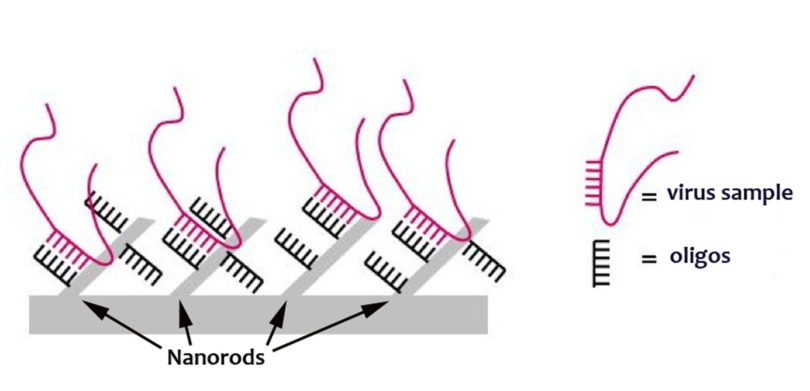Athens, Ga. — The words “laser beam” often conjure up images of high-powered energy weapons or concert light shows, but lasers have many other applications and fighting the deadliest types of flu may soon be added to the list.
University of Georgia researchers are refining a nanotechnology-based method that uses laser light beams to more accurately predict emerging influenza strains-particularly strains with a risk of high mortality. The work will be funded by the National Institutes of Health and will total $1,124,914 over the next four years.
Influenza kills thousands of people each year worldwide-the Centers for Disease Control and Prevention estimates that 3,000 to 49,000 flu-related deaths occurred annually in the United States alone from 1976 to 2007. Millions are immunized every year against influenza, but vaccines aren’t always effective because it is difficult to predict the flu strain for a given year.
Richard Dluhy, professor of chemistry in the Franklin College of Arts and Sciences, along with Stephen Tompkins and Ralph Tripp, associate professor and professor of infectious diseases in the College of Veterinary Medicine, respectively, are refining a method used to identify virus strains so researchers can quickly detect components in viruses that affect influenza virulence.
Virulence-how easy or difficult it is for a disease to be passed along or to kill its host-is determined by the presence of molecules called virulence factors. Studies have shown that different types of influenza may contain the same virulence factors. The same protein, for example, was found in the different virus strains that caused both the 1997 Hong Kong bird flu and the 1918 pandemic known as the “Spanish flu” that killed nearly 50 million people. If certain proteins and other molecules within the viruses can be associated with particularly virulent strains of influenza, epidemiologists might be able to prevent the spread of those strains.
“Currently there is no way to screen for the biochemical markers of influenza virulence,” said Dluhy, principal investigator for the project. “The ability to routinely screen influenza isolates for virulence factors would be a highly significant advance.”
Employing a method he developed several years ago with UGA physics professor Yiping Zhao, Dluhy and his team will deposit a layer of microscopically thin silver wires called nanorods on a glass plate so the wires project at an angle from the plate. Fragments of synthetic nucleic acids known as oligonucleotides, or oligos, will be chemically attached to the nanorods. The oligos will capture bits of the influenza genetic material from virus samples, creating an oligo-virus complex. Researchers will then expose the oligo-virus complex to a laser beam, which can penetrate the biological material without harming it. The angled wires amplify the beam as it reflects off the nanorod surface and the oligo-virus complex-a process called surface-enhanced Raman spectroscopy, or SERS. The amplification enables the researchers to record minute changes in the reflected beam’s frequency and intensity. The SERS measurements, which resemble the squiggles on a seismograph chart, are unique for different strains of viruses, much like a fingerprint.
The method, also known as nano-optical detection, has proven viable for identifying whole viruses, but Dluhy, Tompkins and Tripp will take the process a step further by identifying virus components-the virulence factors-that survive from strain to strain.
“Nano-optical detection will help epidemiologists predict the appearance of deadlier flu strains with greater accuracy,” said Dluhy. “It will enable researchers to prepare the right types of vaccines far in advance of outbreaks.” The method, said Dluhy, may also entirely eliminate pandemics-world-spanning epidemics-if potential outbreaks can be spotted early and controlled with regional vaccination programs.
The research is supported by the National Institutes of Health project grant 1R01GM102546-01.
UGA Franklin College of Arts and Sciences
The Franklin College of Arts and Sciences, founded in 1801, is the oldest and most academically diverse college at the University of Georgia, comprising 30 departments in five divisions: Fine Arts, Social Sciences, Biological Sciences, Physical and Mathematical Sciences, and the Humanities. In addition to educating more undergraduates than any college on campus, the Franklin College offers 76 graduate degrees and certificates in 42 fields of study. For more information visit www.franklin.uga.edu/.
UGA College of Veterinary Medicine
The UGA College of Veterinary Medicine, founded in 1946, is dedicated to training future veterinarians, to conducting research related to animal and human diseases, and to providing veterinary services for animals and their owners. Research efforts are aimed at enhancing the quality of life for animals and people, improving the productivity of poultry and livestock, and preserving a healthy interface between wildlife and people in the environment they share. The college enrolls 102 students each fall out of the more than 800 who apply. For more information, see www.vet.uga.edu.








